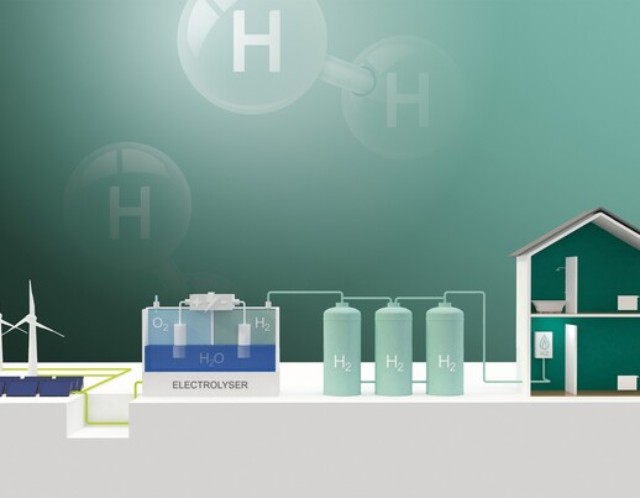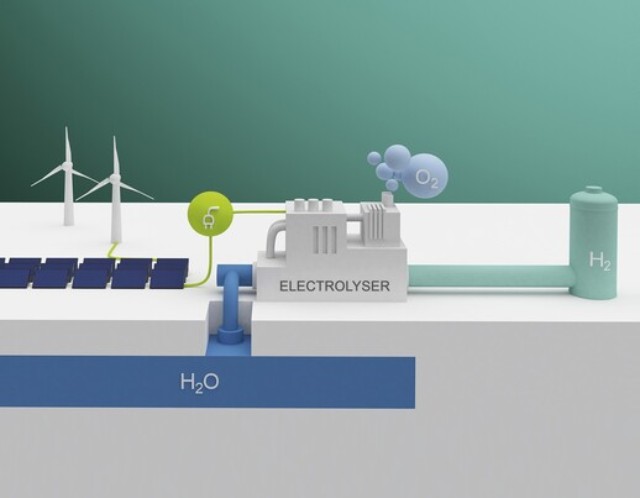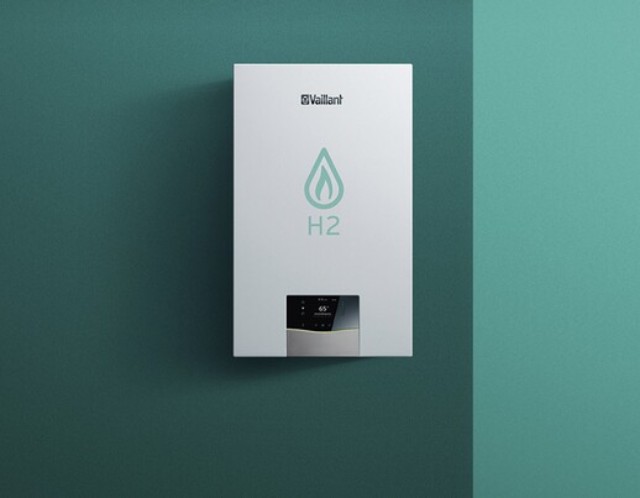{card_headline}
{card_text}
Read more
The Vaillant Group develops heating appliances based on hydrogen. As a CO₂-neutral gas, hydrogen can contribute to the decarbonisation of buildings. It’s not just the environment that benefits.
When it comes to a forward-looking energy supply, hardly any other topic is currently being discussed more frequently than hydrogen. Hydrogen in industry. Hydrogen in traffic. Hydrogen for building supply. Hydrogen as a fuel releases no CO₂ emissions if it is produced from renewable energy sources. It can contribute to decarbonisation across sectors. It can be utilised very flexibly. And it is easy to transport and store due to its different states of aggregation.
In the industrial sector, a major challenge is to make highly CO₂-emitting branches of industry more environmentally friendly, such as the steel industry or the chemical industry. In traffic and transport, the focus is on using hydrogen in local public transportation, heavy goods transport and in shipping and aviation. In buildings, hydrogen could also become an integral part of the energy mix as a “green” gas. As a second mainstay alongside electricity-powered heat pumps.

The EU has by now developed a comprehensive hydrogen strategy as part of a climate-neutral Europe. The heating sector is also part of this strategy. By around 2030, so-called “hydrogen valleys”, i.e. regional hydrogen ecosystems, are to be created. In these, residential and commercial buildings are to be supplied with heat from locally produced hydrogen that is transported over short distances. Environmentally neutral and sustainable.
To support the EU hydrogen strategy, the “European Clean Hydrogen Alliance” has been founded. The alliance is an association of decision-makers along the entire hydrogen value chain. Roadmaps as a basis for political decision-making processes and viable investment projects are being developed here. The Vaillant Group is one of the members of the alliance and contributes its know-how. “As a member, we have the opportunity to actively shape planning processes and projects,” says Christoph Schreckenberg, Senior Manager in the Association and Standardisation department. “Our primary goal is to firmly integrate the building sector into the strategies and plans around hydrogen use.”
At the national level, hydrogen has long been a topic of attention. In Germany, a national hydrogen strategy has been in place since 2020. A national hydrogen council has been set up to implement the federal government’s strategy. Germany is earmarking seven billion euros for the market ramp-up of hydrogen technologies, plus another two billion for international partnerships.

The Netherlands, France, Spain, Portugal and Norway have also developed their respective national hydrogen strategies in 2020. Followed by Austria and Poland. Other European countries are currently working on it. Italy and Slovakia, for example.
In order to be prepared for changing technical requirements, the Vaillant Group is active throughout Europe in various associations, committees and networks. Work is being done on future standards for European and national gas quality and for energyefficient gas heating appliances. The focus is also on technical aspects with regard to the admixture of hydrogen into the existing natural gas grid or the use of 100 per cent hydrogen heating appliances.
Hydrogen undoubtedly has the potential to be a cornerstone of the European energy transition. For this to happen, however, the hydrogen must be produced CO₂-free on the basis of renewable energies, as so called “green” hydrogen. So far, no large quantities of green hydrogen are available. Hence, it will take time for hydrogen to develop its full potential. Production capacities have to be created, as well as pipeline and distribution networks, transport and storage facilities. In addition, uniform technical standards still have to be defined. For at present there are no harmonised standards for the percentage of hydrogen that may be added to existing gas grids. The percentage varies between zero and ten percent across European countries. European harmonisation is a long-term undertaking.
In the heating market, two scenarios are currently being pursued in order to do the “homework” as a sector: First, as a transition scenario, a hydrogen admixture in the existing natural gas grid of 20 percent. Secondly, the use of hydrogen in its pure form as a completely CO₂-free fuel. More of a long-term goal for the period between 2030 and 2050. In Great Britain, in Germany and in the Netherlands, field tests by gas utility companies are now underway, which are providing insights into possible blending rates.

In the segment of gas condensing boilers, CE certification for a 20 per cent hydrogen admixture is currently being prepared for several Vaillant appliance generations. These include the ecoTEC plus and ecoTEC exclusive model series. Both are equipped with the gas-adaptive ioniDetect combustion system. This enables the appliances to automatically adapt to fluctuating gas qualities, including those with hydrogen content. In the latest generation of appliances, the proportion of hydrogen can even be around 30 per cent.
The Vaillant Group is also prepared for the use of pure hydrogen as a completely CO₂-free energy source for gas heating appliances. A ready-for series appliance for the combustion of 100 per cent hydrogen is being tested. “Special challenges arise with this technology because of the different properties of hydrogen and natural gas,” explains Michael Paul, who is heading the responsible for the “100 per cent hydrogen” project. Due to the specific combustion properties of hydrogen, a new burner must be used, among other things, and other components of the heat cell must be adapted to the properties of hydrogen.
Besides CO₂-neutral combustion for energy generation, hydrogen has other positive qualities, especially in the heating sector: Heaters based even on pure hydrogen can be constructed in such a way that they have the same dimensions as natural gas boilers. This simplifies appliance replacement in existing buildings and means that installers will not have to deal with new requirements. Only a gas meter and a new pressure controller would have to be replaced in the building installation. The efficiency of the appliances is also similar to that of gas condensing boilers. Consequently, existing radiators and condensing gas flue systems can still be used after replacement. Customers benefit from all these advantages.
Planned next steps are participation in demonstrator field test projects. At present, hydrogen pipelines and infrastructures are being built locally within the framework of stand-alone projects, for example in the United Kingdom, the Netherlands or Germany. The Vaillant Group is in close dialogue here with the responsible energy utility companies and research institutions. As a manufacturer, the Vaillant Group thus ensures that its customers and partners are prepared for the coming hydrogen era, even before it has really begun.
{card_headline}
{card_text}
